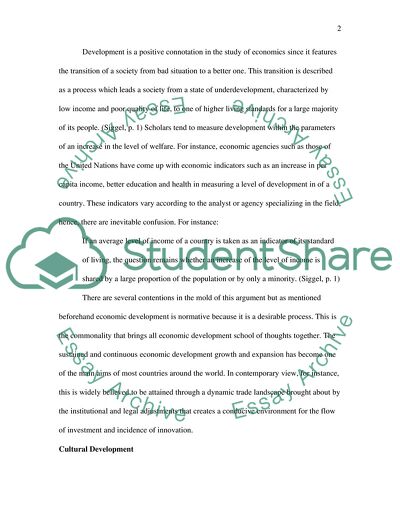
- Home
- Free Samples
- Premium Essays
- Editing Services
- Extra Tools
- Essay Writing Help
- About Us
- Studentshare
- Subjects
- Miscellaneous
- What is meant by 'development'
What is meant by 'development' - Essay Example
While history chronicled a timeline of developments, for instance, starting…

- Subject: Miscellaneous
- Type: Essay
- Level: Undergraduate
- Pages: 4 (1000 words)
- Downloads: 0
- Author: bergnaumaidan
Extract of sample "What is meant by 'development'"
1), it is an outcome of a process which can be accelerated and guided by planning, so our parameters are set to limit on humans – being the ones capable of such faculty. Development is seen as multi-dimensional, involving changes in structure and capacity, as well as output. Three different, but overlapping, approaches to the definition of indicators are distinguished first, the definition of indicators in the context of theoretical models of development, socio-political as well as economic; second, the use of indicators in the empirical study of interrelations between economic and non-economic factors; third, the development of indicators for policy and planning. (p. 1) Development is a positive connotation in the study of economics since it features the transition of a society from bad situation to a better one.
This transition is described as a process which leads a society from a state of underdevelopment, characterized by low income and poor quality of life, to one of higher living standards for a large majority of its people. (Siggel, p. 1) Scholars tend to measure development within the parameters of an increase in the level of welfare. For instance, economic agencies such as those of the United Nations have come up with economic indicators such as an increase in per capita income, better education and health in measuring a level of development in of a country.
These indicators vary according to the analyst or agency specializing in the field, hence, there are inevitable confusion. For instance: If an average level of income of a country is taken as an indicator of its standard of living, the question remains whether an increase of the level of income is shared by a large proportion of the population or by only a minority. (Siggel, p. 1) There are several contentions in the mold of this argument but as mentioned beforehand economic development is normative because it is a desirable process.
This is the commonality that brings all economic
...Download file to see next pages Read More
- TERMS & CONDITIONS
- PRIVACY POLICY
- COOKIES POLICY